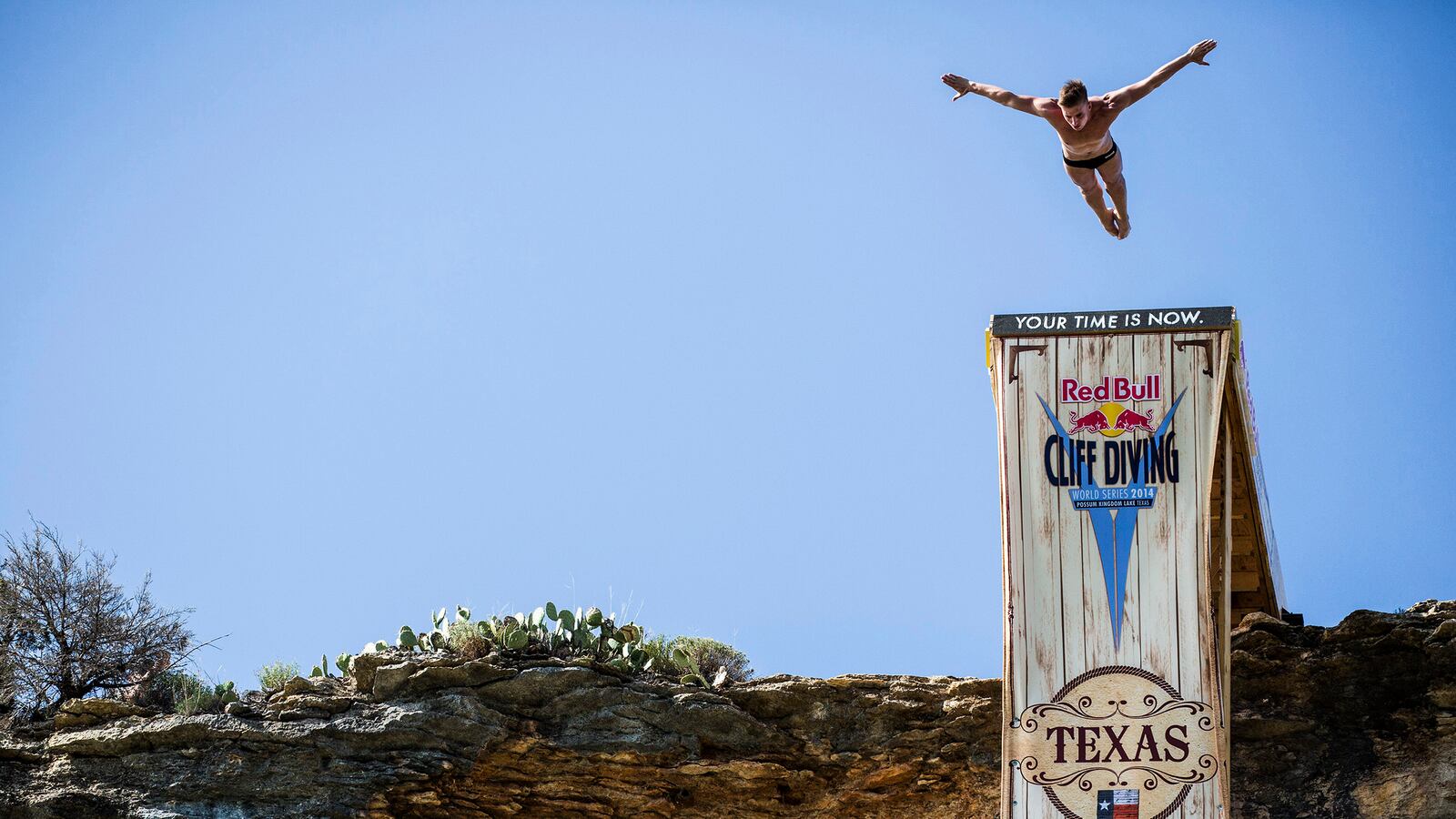Two hours east of Dallas, sun-drenched granite cliffs loom high above the cloudy waters of Possum Kingdom Lake. A pair of diving platforms jut from the gold and red stone. The higher of the two is perched 27 meters above the lake's surface –– about the same height as an eight-story building. Again and again, watched by several thousand fans bobbing in the lake below, svelte young athletes walk to the platform's edge, wave to the crowd, take a moment to gain their composure, then fling themselves over the edge.

For roughly three seconds they fall, twisting and tumbling, reaching speeds of nearly 60 miles per hour before striking the water's surface. A ring of safety swimmers closes in around them. Flashing “OK” signs, the safety crew waits for the divers to pop up and flash an “OK” back. If the dive went well, the divers also will probably pump a fist and smile, then swim to shore and await scores from judges on a nearby pontoon boat.
That was earlier this month, on the second stop of the 2014 Red Bull Cliff Diving World Series. The weather –– and water –– will be much different this weekend. June 28 and 29, the tour stops at the island of Inis Mór, off the Irish coast. There, atop a grim, gray rock formation called Serpent’s Lair, divers will plunge into the cold saltwater of the North Atlantic. The tour then goes to Norway for dives of a fjord, followed by stops in Portugal, Ukraine, Spain, and a season finale in Brazil.
Despite the name, cliff divers do neither. Unlike, say, weekend daredevils or natives who dive to entertain the tourists in Maui and Acapulco, Red Bull athletes do not leap from natural stone ledges. They take off from sturdy wood platforms covered by a non-slip polyurethane surface.
They also do not dive. A dive, strictly speaking, means entering the water headfirst. Red Bull competitors may flip, pike, twist, twirl and triple-somersault on their way down, but they must enter feet-first, toes pointed, bodies rigid and straight, lest they crack a spine or bust a lung. Or, like, die. That's why medical teams, replete with Life Flight helicopters, are always on standby at tour events. Three times at last year's events, divers were knocked unconscious by the impact of hitting the water, and virtually all have tales of an off-kilter entry that tears muscle from bone or rips skin from flesh.
High diving, however, is more than an exhibition of derring-do. It's a legitimate sport. Or, more accurately, it's trying to become one, moving from a tourist spectacle to an accepted discipline in the already-established sport of diving. Last year, high diving made its debut at the International Swimming Federation’s world championships. This August, Russia will host the inaugural edition of the High Diving World Cup, and there's a movement afoot to add high diving as an event to the 2020 Olympic Games.
Remarkably, the sport's legitimization is happening almost exclusively because of Red Bull. With the possible exception of Winston cigarettes and their early sponsorship of NASCAR, there's never been a corporate sponsorship to have so dramatically impacted the growth of a sport.
True, in the 1970s, the La Quebrada Cliff Divers of Acapulco were a popular feature on ABC's Wild World of Sports. The World High Diving Federation, established in 1996, is recognized by the Olympic Committee as the sport's governing body. But it's Red Bull, forming the World Series in 2009, that's bringing cliff-diving to a mass audience by staging and sanctioning competitions around the world–and by securing a three-year broadcast deal with Fox Sports.
Greg Louganis, four-time Olympic gold medalist, is also a judge on this year's tour. Lakeside in Texas, baked by the heat, Louganis described how Red Bull got him to lend his credibility to the competition.
“When they approached, I was little skeptical because I had been commentator for Acapulco cliff diving. That was very different atmosphere. It was party-ish. It didn't really have the finesse. Red Bull was different. They had standardized the height of the platforms, standardized the rules. They were using the FINA degree of difficulty. Sanctioning and running this event, they showed they were really taking the sport of diving seriously.”
Louganis is among those who want a high-dive event in the Olympics, and there is a compelling case. Olympic Diving currently includes competitions on 1-meter, 3-meter, and 10-meter platforms, plus a synchronized version of the sport. Leaping from 27 meters nearly triples the time that athletes spend in the air, allowing for dives that are far more complicated, difficult, and entertaining to watch.
But there also arguments against having high-dives in the Olympics event. Namely, there simply aren't that many people who do it.
Granted, there's an international flavor to the Red Bull series. Reigning champ Gary Hunt comes from the United Kingdom. David Colturi and Steve LoBue are from the USA. Artem Silchenko is Russian. Orlando Duque is from Colombia.
Though wide, however, the talent pool is not deep. That's partially because of sheer logistics. You can stage a springboard or platform diving meet virtually anywhere there's a swimming pool, but it's far more complicated and expensive to safely construct a platform 27 meters in the air. Water depth is also an issue. FINA guidelines require competitive diving pools to be at least five meters deep – or about 17 feet. That can be knotty when you hit the water at 60 mph. High divers, really, need lakes and oceans.
They also need a dash of crazy. Which is the other factor contributing to a small pool of talent. World-class divers are rare enough. High-divers must not only perform dazzling midair gymnastics, they have to do it under the constant threat of death and serious injury. It takes a special kind of person to compete in a sport where even the practice can kill you. It demands with monumental courage, a high tolerance for pain, and at least a touch of insanity. With prizes on the Red Bull tour of just a few thousand dollars, the divers certainly aren't in it for the money.
In truth, that lunacy is a big part of the sport's appeal. Audiences at an Olympic 10-meter diving competition are looking for grace and technical perfection according to a very specific set of rules. Most of the 6,700 Texans who bobbed and floated on Possum King Lake a few weeks ago weren't there to see Gary Hunt's winning, front triple somersault three-and-a-half twist pike. Nor will the 20,000 spectators expected to show up for the series stop in Bilbao, Spain. They won't want to see finesse. They'll come for the dumb, vicarious, but undeniable thrill of watching human beings do something dangerous, and potentially deadly. That, if anything, is the very definition of an extreme sport. For Red Bull, who built their brand selling an adrenaline-fueled lifestyle, that's the whole appeal. But it's also why high-diving might stay stuck in niche status, caught forever between a spectacle and a sport.






